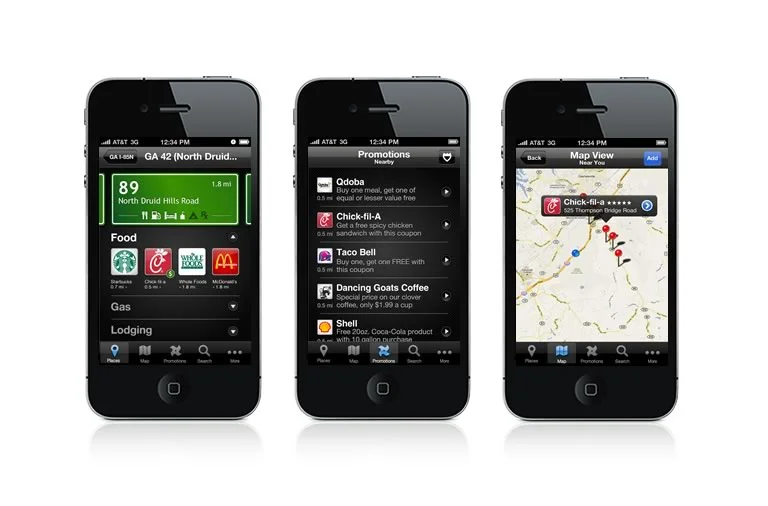Will SmartPhones make location irrelevant?
A few weeks ago, while driving back from Florida to Savannah on I-95, I had a need for a caffeine fix. You know how these things are – those long drives on straight, fast highways often require some extra stimulation. Jamie reached over to her trusty Iphone, and used one of the apps (Road Ninja? Yelp?) and found the nearest exit with a Starbucks, and the exact location. Combined with the trusty Google Maps app, we easily found it in a somewhat hidden strip center, and headed on down the road. Those billboards and blue directory signs were completely unnecessary.
The experience got me to thinking about how one of our precious rules of retailing is quickly becoming irrelevant. The rule? Location, location, location.
That’s right – the sacred mantra of real estate that states what the 3 most important characteristics for success are.
First – a brief history of real estate. First, you had to be near water. Then, you had to be near rail. Then, you had to be near a busy road. That brings us to today. Like I said – brief.
We’ve held to the notion of the importance of location for obvious reasons. If you’re in the retailing business, for example, you want people to see your business, and know that it’s there. Whether or not someone stops when they see it immediately is irrelevant – the key is that your presence has been fixed in their brain. When they want to visit, they’ll know where to go, because they see it or pass by it often.
In the days when people primarily got around on foot or streetcar, this led to commercial strips, main streets and neighborhood centers at important stops on the route. In the switch to cars, it led to every retailer wanting to locate on the busy commercial highway strips, so that drivers could see their stores. Even in the revival of main-street style retail and urban retailing, the presence of cars going by has been critical. It’s a key factor why so many of us decry pedestrian malls – their lack of car traffic drastically reduces the number of “eyes on the stores”, and thereby reduces the customers. Result: businesses don’t want to locate there. This is the case whether it’s a grocery store, a drugstore, or a coffee shop. Businesses simply need visbility.
Or so we thought.
That world that we’ve all become familiar with in planning and development appears to be on the verge of turning upside-down. In the new world of commerce, every business drives people to their stores with Facebook pages, reviews on Yelp and Urbanspoon, and specials via Twitter. A plethora of smart phone apps can easily lead you to any category of business. Food trucks in many cities even change their locations daily, and tweet them to their thousands of followers.
I no longer need to walk or drive by a business to know it’s there – I simply need to access its location on my phone, and follow the GPS-enabled map to get there.
The real question is – how will I know how to find Dairy Queen? (hint: use the Find DQ app) No, of course the real question is how will this technological change impact how we use our cities and towns, and how real estate is valued? That’s clearly two questions, but if you read this far, you know how they are related.
If a business knows that it can reach its customer base through phone apps, Twitter, etc, will they really care much about their exact location? Does Groupon drive more people to your business then being on a busy street, or near an anchor store?
These questions are un-answerable right now, but it’s unequivocal that the changes taking place will be profound. Savvy entrepreneurs will soon be able to make “B” and “C” locations in conventional terms work far better than they ever did in the past. In fact, some are already doing this.
What will feel more pain – the commercial strip that needs drive-by traffic, or the main street that relies on heavy pedestrian traffic?
Play futurist for a minute – how do you see this affecting your life? Do you have a favorite new business that you follow more on social media than because it’s on a busy street?
If you got value from this post, please consider the following:
- Sign up for my email list
- Like The Messy City Facebook Page
- Follow me on Twitter
- Invite or refer me to come speak
- Check out my urban design services page
- Tell a friend or colleague about this site





